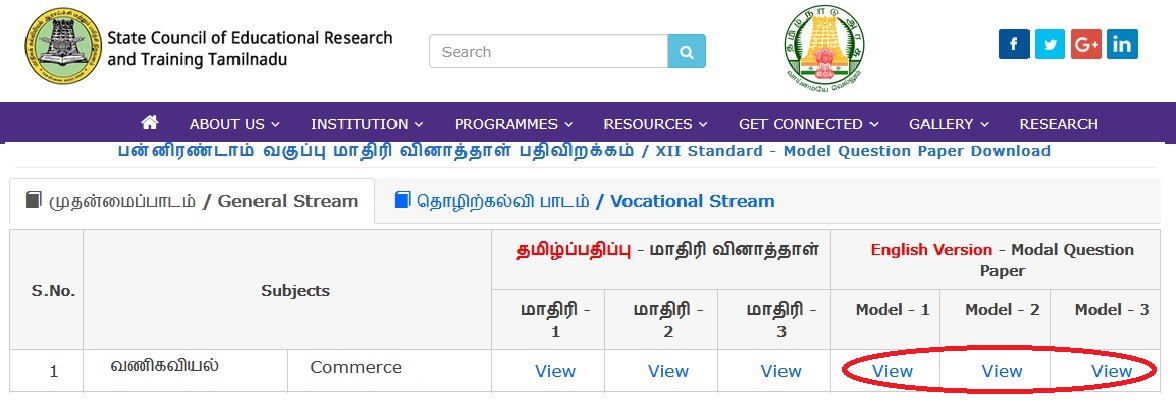TNSCERT XII Standard Commerce Model Question Paper 2019 : Educational Research and Training Tamilnadu
Organisation : State Council of Educational Research and Training Tamilnadu
Exam : Higher Secondary Second Year
Document Type : XII Standard – Model Question Paper Download
Category or Subject : Commerce
Website : http://www.tnscert.org/webapp2/xiimodelquestionspaper.aspx
TNSCERT XII Standard Commerce Model Question Paper
The Government of Tamil Nadu has taken a policy decision on reducing the maximum marks for Higher Secondary Board Examination from 1200 to 600 in order to reduce the examination stress of students besides reducing the number of papers for Language subjects from two to one.
Related : TNSCERT XII Standard History Model Question Paper 2019 : www.pdfquestion.in/34014.html
Note :
** These are only model questions. Teachers and students need to focus only on the Pattern of the questions.
Commerce
Time : 2.30 Hours
Marks : 90

Part-A
Choose the correct answer: 20×1=20
1. ……………………………..should be the watchword of the organisation.
a. Co-ordination
b. Efficiency
c. To earn profit
d. Simplicity
2. Membership by birth is the main feature in……………………..
a. Sole trader
b. Joint Hindu Family Business
c. Co-operative Society
d. Partnership
3. The most suitable form of organisation for operating defence industries is…………………………
a. Government company
b. Public Corporation
c. Departmental organisation
d. Board organisation
4. “One-man control is the best in the world” was said by………………………………..
a. William R.Basset
b. O.R. Krishnaswamy Pillai
c. Stephenson
d. Carter
5. A sole trader…………………………….
a. Can maintain the business secrets
b. Can’t maintain the business secrets
c. None of the above
d. Option a & b
Download Question Paper :
Model – 1 :
https://www.pdfquestion.in/uploads/pdf2019/34024-Comm1.pdf
Model – 1 :
https://www.pdfquestion.in/uploads/pdf2019/34024-Comm2.pdf
Model – 1 :
https://www.pdfquestion.in/uploads/pdf2019/34024-Comm3.pdf
6. Sole trading business can be started by……………………………
a. Atleast two persons
b. Atleast seven persons
c. Any one person
d. All the above
7. The partner’s liability in India is……………………….
a. In an agreed ratio
b. Unlimited liability
c. Capital contributed by the partners
d. Limited liability
8. In partnership there exists a relationship of……………………………….
a. Principal and agent
b. Owner and Servant
c. Employer and employee
d. All the above
9. The basis of partnership is………………………..
a. Utmost good faith
b. Money available for investment
c. Desire to work
d. To earn profit
10. The aggregate nominal value of qualification shares shall not exceed…………………………..rupees.
a. Rs.6,000/-
b. Rs.10,000/-
c. Rs.5,000/-
d. Rs.2,000/-
11. The minimum subscription specified in the prospectus must be received within…………………..
a. 90 days
b. 120 days
c. 130 days
d. 60 days
12. The time gap between two consecutive annual general meetings should not exceed…………………months.
a. 15
b. 12
c. 18
d. 20
13. A person can hold directorship of not more than……………………..public limited companies.
a. 10
b. 15
c. 20
d. Limitless
14. The overall maximum managerial remuneration in a public limited company shall not exceed……………..
a. 11% of net profits
b. 11% of paid up capital and free reserves
c. 5% of net profits
d. 5% of paid up capital and free reserves
15. Stock exchanges deal in……………………………………
a. Goods
b. Services
c. Financial Securities
d. Country’s Currency
16. A pessimistic speculator is…………………………….
a. Stag
b. Bear
c. Bull
d. Lame Duck
17. Brokers are………………………………..
a. Jobbers
b. Commission Agents
c. Members
d. Remiser
18. The father of the Co-operative movement was……………………………….
a. Stephenson
b. Dumas
c. Robert Owen
d. Kimball and Kimball
19. The minimum number of members to form a Co-operative society is…………………………
a. 2
b. 7
c. 10
d. 25
20. In a government company the share capital of the government must not be less than……………….
a. 51%
b. 60%
c. 75%
d. 90%
Part-B
Answer any 7 Question: (Question No.21 is compulsory) 7×2=14
21. What are the functions of Business?(any four)
22. State the various kinds of non-corporate enterprises?
23. What is unlimited liability.
24. Define Partnership?
25. Bring out the difference between dissolution of partnership and dissolution of partnership firm? (any two)
26. What is the consequence of not receiving minimum subscription?
27. What do you mean by a foreign company?
28. What is Proxy?
29. Who is a Speculator?
30. Why departmental organisation is suitable for defence industries?
Part-C
Answer any 7 Question: (Question No.31 is compulsory) 7×3=21
31. For what reasons the study of organisation is important – explain?
32. What are the drawbacks of non-registration of partnership firm?(any three)
33. What is government company?
34. Write a short note on Managerial Remuneration?
35. State the circumstances in which a director can be removed?
36. Explain – Mutual Funds?
37. State the meaning of supermarket and explain its features? (any five)
38. What are the differences between public and private sector? (any three in each)
39. State any three features of departmental organization?
40. Explain any two kinds of Speculators?
Part-D
Answer all the questions: 7×5=35
41. What do you understand by multinational companies? Explain its features?
(or)
Explain the objectives of state enterprises? (any 5)
42. Explain the role of sole trading concern in the society? (any 5)
(or)
Explain demerits of a co-operative society? (any 5)
43. What are the circumstances under which a partnership firm is dissolved? (any 5)
(or)
Explain the functions of SEBI? (any 5)
44. Bring out the distinction between a company and a Partnership? (any 5)
(or)
Discuss the powers of Directors? (any 5)
45. Distinguish between shares and debentures? (any 5)
(or)
Write explanatory notes on a) Proxy b) Quorum c) Minutes
46. Define Stock Exchange. Explain its characteristics and functions? (each 3 points)
(or)
Explain any eight types of Co-operative societies in detail? (any 5)
47. Difference between sole trader and partnership? (any 10)
(or)
What are the benefits of a Stock Exchange? (any 5)